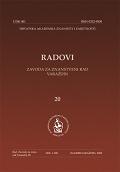PRILOG ISTRAŽIVANJU STUCCO - DEKORACIJE KAPELE SVETA TRI KRALJA U HODOČASNIČKOJ CRKVI U KOMINU
CONTRIBUTION TO THE RESEARCH OF THE STUCCO - DECORATION IN THE CHAPEL OF THE THREE WISE MEN IN THE PILGRIMAGE CHURCH IN KOMIN
Author(s): Ana KaniškiSubject(s): Architecture
Published by: Hrvatska akademija znanosti i umjetnosti - Zavod za znanstveni rad Varaždin
Keywords: Chapel of the Three Wise Men; Komin; stucco-decoration; 1710-1720; Antun Johann Quadrio’s workshop
Summary/Abstract: The interior of the Chapel of the Three Wise Men in the pilgrimage church in Komin near Varaždin is stucco-decorated with white plaster on a rose coloured wall surface. The plaster is moulded into tendrils, bindweed leaves and flowers, animals and human figures, namely four angels holding a votive altar dedicated to the Three Wise Men, who bore gifts to Jesus Christ (1710). This stucco-decoration was first mentioned in the canonical visitation from 1720 within a small chapter in the description of the pilgrimage church, which moves the date of its creation (previously thought to be 1738, due to a different description in a visitation) between 1710 and 1720. In that period, the only known and active stucco-artist in the Komin area was Antun Johann Quadrio (active at the end of 17th century and the first three decades of the 18th century), an Italian artist who also authored the stucco-decorations in the Chapel of Our Lady of Mount Carmel (1717) in the Franciscan church in Varaždin and the Chapel of St. Francis Xavier (1711) in the former Jesuit church in the same city, as well as the church of St. Catherine in Zagreb (1712, 1721). He is the presumed author of the stucco-decoration of the north stairwell in the former Jesuit monastery (dating from first quarter of the 18th century) in Varaždin. The comparison of Quadrio’s work with the Komin example shows a shared affinity towards accentuating architectural elements with decorations, as well as identical designs and motives. However, the quality of the workmanship is much lower in the Chapel of Three Wise Men in Komin and the details are not as fine. The bodies of the angels are more roughly moulded and there is a harsher feel to their drapery. The mentioned characteristics suggest that the author of stucco-decorations in the Chapel of Three Wise Men was either an assistant or an apprentice in Antun Johann Quadrio’s workshop, somebody who borrowed Quadrio’s templates and moulds for the decoration and motives, but failed to achieve the same level of craftsmanship as his more experienced master and mentor.
Journal: Radovi Zavoda za znanstveni rad Varaždin
- Issue Year: 2013
- Issue No: 24
- Page Range: 275-292
- Page Count: 18
- Language: Croatian

